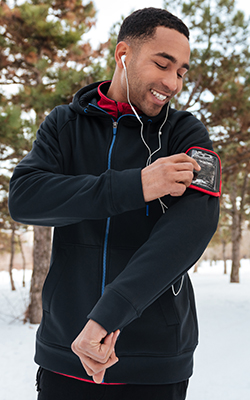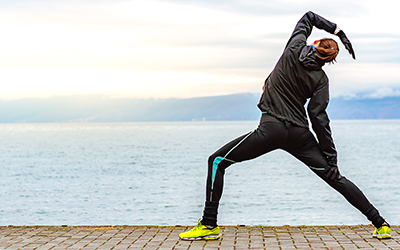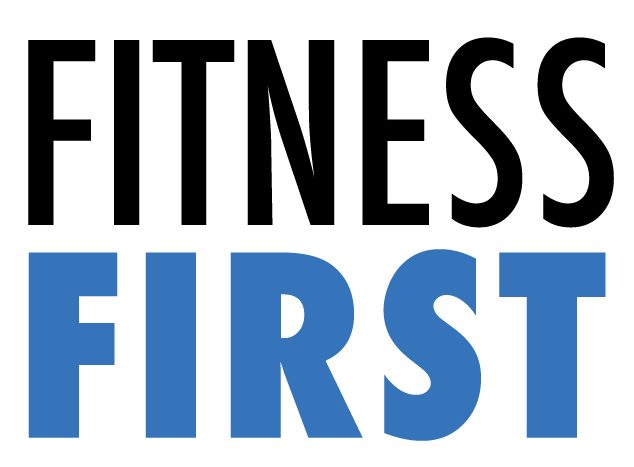
As we head into winter in the Northern Hemisphere, many parts of the US and the rest of the world will begin to experience colder temperatures.
But just because the temperatures drop, you don’t have to move your workout into the gym. If you understand how to make the best of your cold-weather training, you will be able to keep exercising outside long after everyone else has shifted inside.
Benefits of Cold Weather Training
Exercising outdoors in cold weather offers benefits that you can’t get in the confines of a temperature controlled gym. Consider these as reasons to step outside for your run or other workout.

Immune Boost
Studies show that exposure to natural sunlight and fresh air at any time of year boost your immune system and your overall health.
The sunlight exposure provides your body with Vitamin D, an essential vitamin that can impact bone health and heart disease. Spending time in the sun, especially during the winter when the days are shorter, can improve mood and sleep.
Inhaling fresh, outside air carries health benefits as well. Typically it allows you to take deeper, longer breaths. These deeper breaths increase the amount of oxygen you can transport to the rest of the body. Meaning that you can work harder and longer than you might otherwise.
Reduce/Eliminate Heat Stress
We know that working out in warmer temperatures places stress on our bodies as we try to dump the excess heat generated by exercise.
Our bodies actually prefer to exert themselves in colder temperatures. As our level of activity increases, our natural responses begin warming us, bringing us to a point where we are comfortable outside.
Again, since your body no longer has to worry about managing elevated core temperatures, you can actually exercise longer and harder in colder temperatures than you might when it’s hot outside.

Burn more Calories and Fat
When you work out in the cold, you might find that you burn more energy than just what your chosen activity requires. There are actually two pathways that lead to this result.
The first will activate with any cold weather activity. Your body spends energy to keep you warm. So when you go for a run or do some jumping jacks, you use up energy not just on moving your muscles, but also on keeping your core temperature elevated. So it’s an instant upgrade to your energy burning.
The second pathway takes some time to kick in. Studies show that our bodies will acclimatize to repeated cold weather exposure by converting white fat, which is an inert energy storage tissue, into beige or brown fat, which actively burns calories to generate heat.
Cold Weather Risks to be Aware Of

Stepping outside to exercise carries some risks to be aware of. Many of these can be mitigated by following our tips below, but you should know about them.
Frostbite and hypothermia are the two main risk factors people consider when thinking about being outdoors in the cold. But these can be managed by protecting yourself from the wind and ensuring that you keep your core temperature up.
Exercise induced asthma, and other breathing issues, can be exacerbated by the cold. If you know that you have any respiratory problems, make sure to be mindful of them before beginning any cold weather training.
Cold weather can make surfaces slippery due to ice or snow. Make sure to be extra careful when running through areas that may have frozen over. A single slip could cause an injury that will keep you sidelined until the spring.
Tips to Stay Safe when Training in the Cold
Now that we understand we should want to train outside in cold weather, and some of the risks to look out for, let’s talk about ways to stay safe.
Layers

Dressing appropriately forms the cornerstone of a practice of outdoor exercise. Your first layer should consist of a close fitting, moisture wicking material that stays close to your body. The next layers should be loose fitting insulating layers. Then make your outermost layer a shell material that will protect you from the wind.
Spending time outdoors in cold weather demands that you regularly adjust your layers as weather conditions and your exertion level change. When you begin, you should feel a little cool. As you exert yourself, you will inevitably warm up. If you dress too warmly to begin, you will start to sweat almost immediately (or find yourself having to stop and remove layers). Sweat leads to wet clothes and wet clothes lead to cold body.
Having layers to work with means you can always make the choice to either increase or decrease insulation as conditions change.
Fueling
We’ve talked a bit about the body’s ability to generate heat in the cold. All of the bodies warming techniques, however, consume energy. To keep those energy reserves high enough, you have to make sure that you are eating plenty of food.
Just like with managing your layers, managing your caloric intake will require a bit of thought. You want to make sure that you’re taking in enough to keep you warm and able to exert yourself. But you want to avoid overeating and consuming excess calories.

Hydration
Dry cold air tends to draw moisture out of us. Combine this with the sweating that comes with exertion, and the moisture we expel with our breath, and you understand why dehydration can still be an issue even in cold weather.
Make sure to drink plenty of water. It might be a good idea to fill your bottle with luke-warm water to help prevent it from freezing and to help keep your core temperature up.
Do your Warm Ups
In cold weather, warm up exercises carry even more importance. They warm up the muscles and help get the blood flowing. In colder weather, our limbs tend to be stiffer and less mobile than at other times.
Performing a proper warm up for all body parts ensure that there is plenty of blood flow and muscle mobility to mitigate the chance of injury.

There is nothing that says that the onset of cold weather means that you can’t go outside to exercise. Cold-weather training, in fact, carries many benefits for the athlete or the person just trying to lose weight. If you take the proper precautions, you might be able to learn to embrace the cold, rather than merely tolerate it until some other goal is met.

